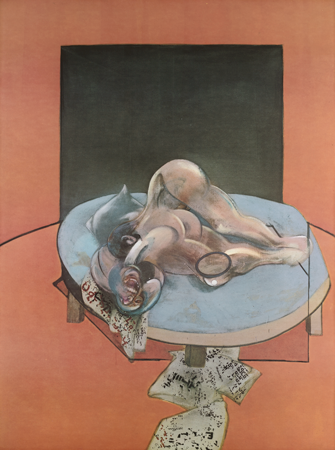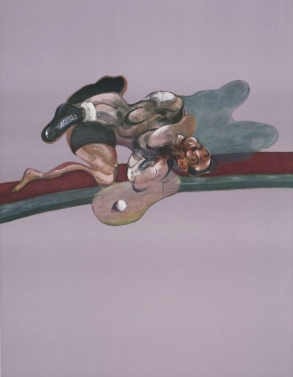Bacon and Freud: Graphic Works
17 January 2016 | 6 – 8 PM
18 January 2017 – 24 February 2017
6 Albemarle Street, London W1S 4BY

Triptych 1983, 1983, A set of three lithographs, edition of 180,
Paper: 86.7 x 60.6 cm (each), Image: 67 x 50 cm (each)
Francis Bacon, Triptych 1983, 1983, a set of three lithographs, edition of 180, 86.7 x 60.6 cm (each), © The Estate of Francis Bacon. All rights reserved / DACS 2016
Marlborough Graphics is pleased to present an exhibition of prints by Francis Bacon and Lucian Freud. The selected works provide an overview of the artists’ graphic output and demonstrate the different approaches each took to printmaking. Friends who rose to prominence in London in the 1950s, Bacon and Freud are widely regarded as the leading figurative artists of the 20th century.
Francis Bacon (1909 – 1992) based his prints on a selection of 35 of his paintings dating from 1955 – 1991. Following a European tradition of artists collaborating with master printers which dates back to the Renaissance, Bacon worked with skilled French, Italian and Spanish printers on a relatively small body of lithographs and a few etchings (totalling only about 40 editions). Marlborough started working with Bacon in 1958 and has carried his graphic works since they were made. Frankie Rossi, Director of Marlborough Graphics explains:
Bacon wanted his prints to look as close to his paintings as possible – his attention to detail and desire for perfection are evident in these works. Prints were produced under his supervision and he personally made changes to proofs when necessary, always ensuring the right colour balance was achieved.
Triptych, 1991 (right-hand panel), Etching and aquatint,
edition of 84, Paper: 163 x 121 cm, Image: 135 x 100 cm
In the lithograph Study for a Portrait of Pope Innocent X (1989), like Bacon’s oil paintings, the work simultaneously repels and intrigues the viewer with its bold, grotesque figure. This paradox remained consistent across his print work. In one of Bacon’s final works, the striking triptych Studies for Self-portrait, the artist’s distorted head emerges from a black background, a representation of the evils and devastation of the human condition. All Bacon prints Marlborough exhibits and deals in were created, approved and signed in his lifetime – with the exception of three editions made in the year of the artist’s death, which he approved but did get the chance to sign. These posthumous prints are stamp signed by the Francis Bacon Estate.
Studies of the Human Body, 1979 (centre panel), Offset lithograph,
edition of 250, Paper: 101.5 x 65.9 cm, Image: 88 x 65.9 cm
Francis Bacon
Born in Dublin, Ireland in 1909, this prominent British painter and printmaker created controversial art until his death in 1992. Despite the fact that he did not receive formal training, Bacon gained instantaneous recognition in 1945 after an exhibition at Lefevre Gallery in London that included his 1944 triptych Three Studies for Figures at the Base of a Crucifixion. Bacon’s figures can be described as distorted, fleshy masses in anguish; these shocking and unsettling images are his representation of the evils and the devastation of the human condition. Bacon’s oil paintings simultaneously repel and intrigue the viewer with their bold, grotesque figures. This paradox remains consistent with his print work, which he based on a selection of thirty-five of his own paintings dating from 1965-1991. Bacon worked with skilled printers to create his relatively small body of etchings and lithographs that total only about 40 editions.
In 2008 and 2009, a major retrospective of Bacon’s paintings traveled to the Tate Britain, London, England (September 11, 2008- January 4, 2009), to the Museo Nacional del Prado, Madrid, Spain (February 3- April 19, 2009) and to the Metropolitan Museum of Art, New York (May 20- August 16, 2009). Bacon’s works are permanently part of public collections around the world, including the Astrup Fearnley Museum, Oslo, Norway; Birmingham Museums & Art Gallery, Birmingham, England; Hirshhorn Museum and Sculpture Garden, Washington, D.C.; Museum of Modern Art, New York; Kunsthaus Zürich, Zurich, Switzerland; Museo de Arte Contemporáneo de Caracas Sofía Imbert, Caracas, Venezuela; Museo Nacional Centro de Arte Reina Sofía, Madrid, Spain; Museo Thyssen-Bornemisza, Madrid, Spain; Modern Art Museum of Fort Worth, Fort Worth, Texas; Peggy Guggenheim Collection, Venice, Italy; Sammlung Essl, Klosterneuburg, Austria; Sprengel Museum Hannover, Hannover, Germany; Stedelijk Museum voor Actuele Kunst, Gent, Belgium; Tate Britain, London, England; and the Tate Modern, London, England.
Francis Bacon, Study for a Portrait of Pope Innocent X, 1989, lithograph,
115.6 x 76.8 cm, © The Estate of Francis Bacon. All rights reserved / DACS 2016
Lucian Freud (1922 – 2011) created his first etching in Paris in 1946, but the height of his graphic output was in the 1990s. The marks and techniques he employed during the etching process were a natural progression from his work as a draughtsman. In his paintings and prints, the influence of one medium on the other can be seen. His subjects were those close and familiar to him, though often anonymous to the viewer. Working in a purist manner, all of Freud’s etchings were devoid of colour (bar two editions) and featured minimal backgrounds. Unsettling and unyielding, the works contain a remarkable honesty and an awkwardness that adds to the nervous nature of the images.
Lucian Freud ‘Woman with Arm Tattoo’ 1996, etching, 70.0 x 92.0 cm
In
Woman with an Arm Tattoo (1996), Freud’s interest in the physical qualities of flesh can be seen in the detailed folds of loose skin around the woman’s neck and chest. He reveals both the vulnerability and fallibility of the human body. The wear and tear of experience is imprinted, like this woman’s tattoo, on the body’s surface. Created in the same year,
Self-Portrait: Reflection (1996) is an etching printed in black ink on white wove Somerset paper; the plate left unwiped for printing to create a background tone on the paper. Age 74 at the time, Freud’s hollowed features reveal a disillusioned face with ageing skin, furrowed brow, worn empty eyes and a sinewy neck atop an ample expanse of flesh.
Marlborough Graphics was formed nearly 50 years ago and is a leading publisher and dealer in modern and contemporary prints. As well as publishing work by artists including Francis Bacon, Victor Pasmore, Frank Auerbach, R.B. Kitaj and Paula Rego, Marlborough Graphics deals in prints by Picasso, Matisse, Moore, Nicholson, Hockney and Riley. Marlborough Graphics published a catalogue raisonné of Lucian Freud etchings in 1993 and holds one of the largest collections of Freud etchings for sale in the world.
Francis Bacon, Triptych in Memory of George Dyer, 1971 (left hand panel), offset lithograph, edition of 200, 85.6 x 61 cm, © The Estate of Francis Bacon. All rights reserved / DACS 2016
Self Portrait: Reflection, 1996, etching, edition of 46, 59.4 x 42.7 cm, Freud, Lucian (1922-2011) / © The Lucian Freud Archive / Bridgeman Images.

If you want to announce your event in
EstherArtNewsletter please fill out the form.










